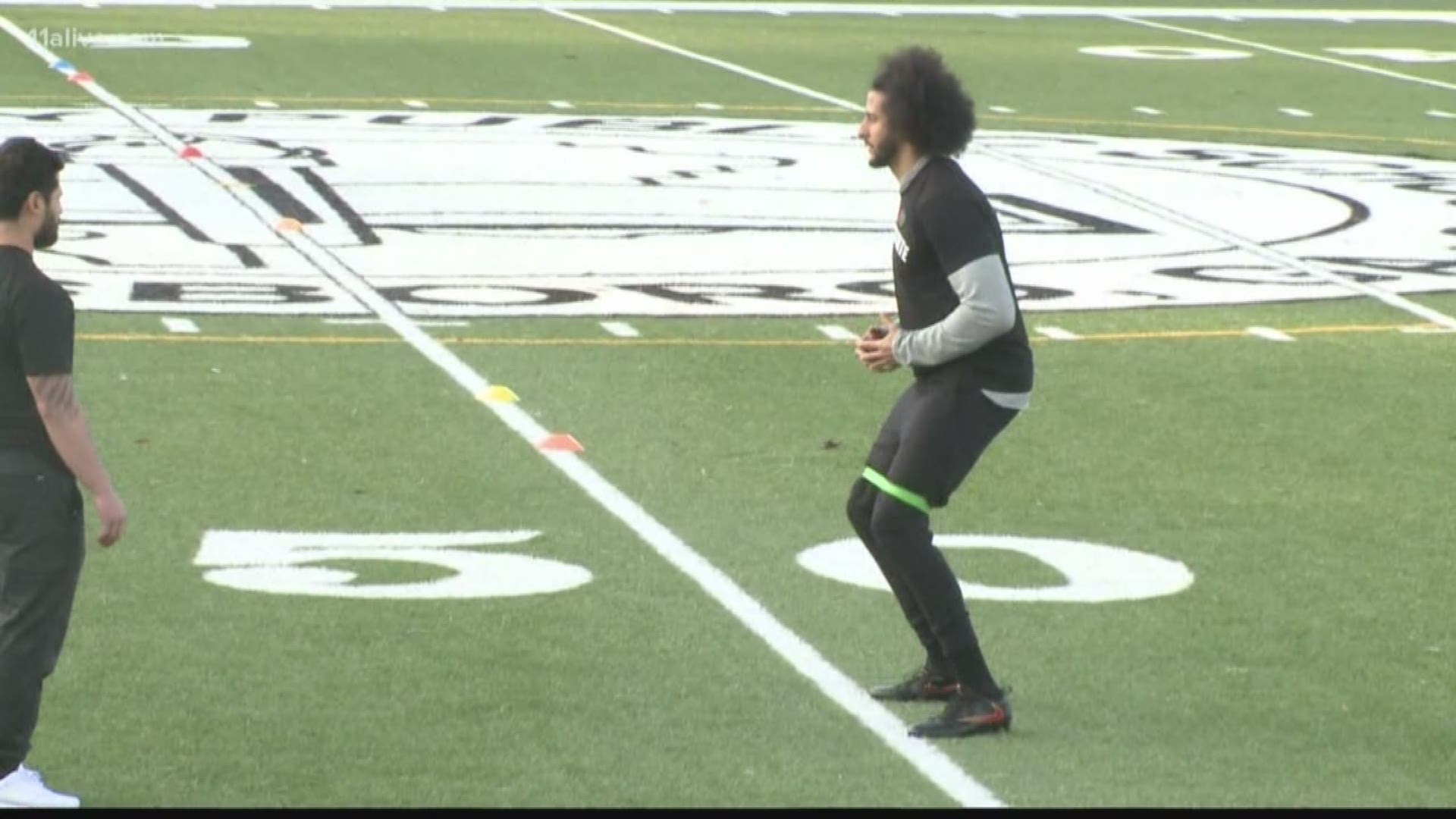ATLANTA — It started with an announcement by Colin Kaepernick's representatives about a half hour before a workout arranged by the NFL was supposed to start on Saturday: They weren't happy with the league's process, and they were going to stage the workout on their own.
The abrupt change in plans set off a scramble that afternoon, with the workout ultimately being at Charles R. Drew High School in Riverdale.
Kaepernick and the NFL have offered competing narratives for what occurred this weekend.
There appear to have been two central sticking points in the proceedings: The legal waiver the NFL wanted Kaepernick to sign to attend the workout, and the event's availability to the news media.
Here's a broader look at what happened:
Legal waivers
The waiver issue gets into complicated legal questions of intent and interpretation.
A waiver in and of itself is a matter of course for this kind of event - if, for instance, Kaepernick were to have hurt himself, the NFL wouldn't want to be sued. You've probably signed one yourself if you've ever gone white river rafting or axe throwing or some other kind of activity that carries any amount of risk for physical injury.
NBC's Pro Football Talk obtained and posted a copy of the NFL waiver. Some of Kaepernick's supporters and surrogates online, including the director Ava DuVernay and Carolina Panthers player Eric Reid, have amplified a tweet by sports legal expert Daniel Wallach, who argued the seventh paragraph in the document in particular could "operate as a backdoor waiver of any future collusion claims."
That is to say, if Kaepernick conducted the workout on the NFL's terms on Saturday and then felt he still went unsigned as a result of league collusion (which an earlier claim resulted in with the league in March for reportedly less than $10 million), his supporters are arguing that specific clause in the waiver would prevent him from being able to claim collusion in this second instance.
"Paragraph 7 is my fave," DuVernay tweeted, citing the waiver language. "Sign this and we’ll let you throw the ball for show."
"The View" co-host Sunny Hostin echoed this argument, responding to ESPN anchor Stephen A. Smith - who has been critical of Kaepernick and his decisions relating to the workout - by saying if he signed the waiver "the NFL could have continued to collude & put out information about his ability with no legal recourse."
"That's not a workout, that's a setup," she wrote on Twitter.
The NFL, for its part, said in a release that it was a "standard liability waiver" the league uses when trying out free agent players and that the alternate waiver Kaepernick's legal team wished to use was "completely rewritten and insufficient."
The NFL Communications Twitter account said they sent the original waiver to Kaepernick's representatives on Wednesday with "no push back" until they presented their own waiver on Saturday, hours before the originally scheduled workout at the Falcons' practice facility in Flowery Branch.
The Kaepernick team's waiver, Sports Illustrated's Michael McCann reported, "signaled he would not have surrendered any right to pursue employment-related claims against the NFL or its teams in the future."
Media presence
The second main issue related to the media's access to the workout.
The workout, as it was set to be staged in Flowery Branch, was going to be closed to the news media.
Kaepernick and his supporters have argued that if he went ahead with a private workout, the league could have characterized it any way they wanted without video evidence to prove their version.
The quarterback said after the workout on Saturday that having media in attendance was about transparency.
"Our biggest thing with everything today was making sure we had transparency in what went on," Kaepernick said. "We weren't getting that elsewhere so we came out here. It's important that y'all are here."
The league's release said it wasn't notified that Kaepernick wanted media to attend until the day of the workout, and that the league agreed to his request to have Nike film the workout for advertising purposes.
Critics like ESPN's Smith have said getting the media involved was less about transparency, and more about generating publicity. Smith went so far as to imply media attention was the whole point of agreeing to the workout in the first place, saying on Twitter: "He don't wanna play. He wants to be a martyr."
Reid, in particular, has forcefully rejected that characterization, and
"That's nonsense. The proof of the workout was to show he can play the game, was to show he can throw the ball, and he did that," ESPN reported he said after Carolina's game on Sunday. "The NFL wanted to control the narrative by not letting independent NFL media into the workout to document the workout."
He also pointed out on Twitter that the NFL Network was using video of the workout to report on it.
"Meanwhile they are using the very video content that would not have been available to them had Colin not demanded transparency," he wrote.
One thing for certain is there was intense public interest in seeing the workout: Since Saturday, 11Alive's stream of the event has gotten nearly 900,000 views on YouTube.
It's unclear what will happen with Kaepernick going forward. While there were reportedly as many as 25 teams at the Flowery Branch workout, ESPN's Adam Schefter says there were only eight in Riverdale.
But, he noted, at least one executive who saw the workout was impressed. Kaepernick, even three years removed from last playing in an NFL game, still has "elite" arm talent.
So there may yet be more to Kaepernick's football comeback.
MORE HEADLINES

